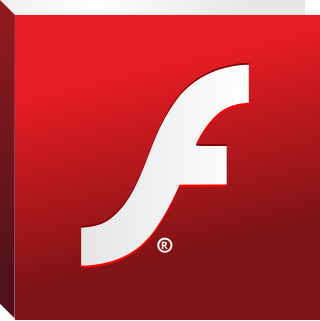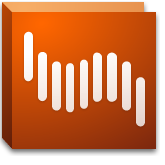Macromedia Flash may refer to:
- Adobe Animate, a multimedia authoring and computer animation program formerly known as Macromedia Flash
- Adobe Flash, a multimedia software platform formerly known as Macromedia Flash
Macromedia Flash may refer to:
Adobe Flash is a multimedia software platform used for production of animations, rich web applications, desktop applications, mobile apps, mobile games, and embedded web browser video players. Flash displays text, vector graphics, and raster graphics to provide animations, video games, and applications. It allowed streaming of audio and video, and can capture mouse, keyboard, microphone, and camera input.

Macromedia, Inc., was an American graphics, multimedia, and web development software company (1992–2005) headquartered in San Francisco, California, that made products such as Flash and Dreamweaver. It was purchased by its rival Adobe Inc. on December 3, 2005.
Adobe Authorware was an interpreted, flowchart-based, graphical programming language. Authorware is used for creating interactive programs that can integrate a range of multimedia content, particularly electronic educational technology applications. The flowchart model differentiates Authorware from other authoring tools, such as Adobe Flash and Adobe Director, which rely on a visual stage, time-line and script structure.
Adobe Creative Suite (CS) is a discontinued software suite of graphic design, video editing, and web development applications developed by Adobe Systems. Each edition consisted of several Adobe applications, such as Photoshop, Acrobat, Premiere Pro or After Effects, InDesign, and Illustrator, which became industry standard applications for many graphic design positions.
SWF is an Adobe Flash file format used for multimedia, vector graphics and ActionScript. Originating with FutureWave Software, then transferred to Macromedia, and then coming under the control of Adobe, SWF files can contain animations or applets of varying degrees of interactivity and function. They may also occur in programs, commonly browser games, using ActionScript.
Adobe Shockwave is a discontinued multimedia platform for building interactive multimedia applications and video games. Developers originate content using Adobe Director and publish it on the Internet. Such content could be viewed in a web browser on any computer with the Shockwave Player plug-in installed. MacroMind originated the technology; Macromedia acquired MacroMind and developed it further, releasing Shockwave Player in 1995. Adobe then acquired Shockwave with Macromedia in 2005. Shockwave supports raster graphics, basic vector graphics, 3D graphics, audio, and an embedded scripting language called Lingo.
A rich web application is a web application that has many of the characteristics of desktop application software. The concept is closely related to a single-page application, and may allow the user interactive features such as drag and drop, background menu, WYSIWYG editing, etc. The concept was first introduced in 2002 by Macromedia to describe Macromedia Flash MX product. Throughout the 2000-s, the term was generalized to describe web applications developed with other competing browser plugin technologies including Java applets, Microsoft Silverlight.
Adobe Flash Player is computer software for content created on the Adobe Flash platform. Flash Player is capable of viewing multimedia contents, executing rich Internet applications, and streaming audio and video. In addition, Flash Player can run from a web browser as a browser plug-in or on supported mobile devices. Flash Player was created by Macromedia and has been developed and distributed by Adobe Systems since Adobe acquired Macromedia in 2005. Flash Player is distributed as freeware. With the exception of the China-specific and enterprise supported variants, Flash Player was discontinued on 31 December 2020, and its download page disappeared two days later. Since 12 January 2021, Flash Player versions newer than 32.0.0.371, released in May 2020, refuse to play Flash content and instead display a static warning message.

Adobe Flash Lite is a lightweight version of Adobe Flash Player, a software application published by Adobe Systems for viewing Flash content. Flash Lite operates on devices that Flash Player cannot, such as mobile phones and other portable electronic devices like Wii, Chumby and Iriver.
Adobe Connect is a suite of software for remote training, web conferencing, presentation, and desktop sharing. All meeting rooms are organized into 'pods'; with each pod performing a specific role Adobe Connect was formerly part of the Adobe Acrobat family and has changed names several times.
In England, Wales and Northern Ireland, the Diploma in Digital Applications (DiDA) is an optional information and communication technology (ICT) course, usually studied by Key Stage 4 or equivalent school students. DiDA was introduced in 2005 as a creation of the Edexcel examination board. DiDA is notable in that it consists entirely of coursework, completed on-computer; all work relating to the DiDA course is created, stored, assessed and moderated digitally. It was introduced as a replacement to plug the gap in ICT education as GNVQs were withdrawn.
Adobe Director was a multimedia application authoring platform created by Macromedia and managed by Adobe Systems until its discontinuation.
Jonathan Gay is an American computer programmer and software entrepreneur based in Northern California. Gay co-founded FutureWave Software in 1993. For a decade, he was the main programmer and visionary of Flash, an animation editor for web pages. He founded Software as Art, which was later renamed Greenbox, which made energy management solutions for the home.
Asao is a proprietary single-channel (mono) codec and compression format optimized for low-bitrate transmission of audio, developed by Nellymoser Inc.
Adobe FreeHand was a computer application for creating two-dimensional vector graphics oriented primarily to professional illustration, desktop publishing and content creation for the Web. FreeHand was similar in scope, intended market, and functionality to Adobe Illustrator, CorelDRAW and Xara Designer Pro. Because of FreeHand's dedicated page layout and text control features, it also compares to Adobe InDesign and QuarkXPress. Professions using FreeHand include graphic design, illustration, cartography, fashion and textile design, product design, architects, scientific research, and multimedia production.
Adobe Animate is a multimedia authoring and computer animation program developed by Adobe Inc.
Sorenson Media was an American software company specializing in video encoding technology. Established in December 1995 as Sorenson Vision, the company developed technology which was licensed and ultimately acquired from Utah State University. The company first announced its codec at a developer’s preview at MacWorld Expo in January 1997.

Adobe Shockwave Player is a discontinued freeware software plug-in for viewing multimedia and video games created on the Adobe Shockwave platform in web pages. Content was developed with Adobe Director and published on the Internet. Such content could be viewed in a web browser on any computer with the Shockwave Player plug-in installed. It was first developed by Macromedia and released in 1995; it was later acquired by Adobe Systems in 2005.